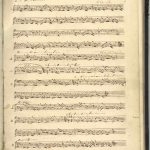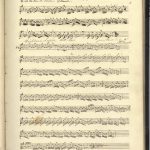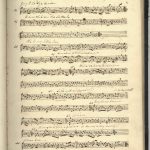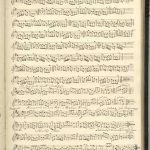This pages allows you to download images of some of the pages in J W Fenwick’s manuscript collection. The handwriting in the titles and the annotations show that the music was transcribed by more than one person, and it is not yet possible to be certain about exactly who the writers were, although it is almost certain that the main transcribers were James Fenwick himself and Cornelius Stanton; some of the annotations may be by Richard Welford or a later owner of the collection.
The downloadable files will focus primarily on the music in the manscript.
The first image shows the first page of collected tunes for the keyless chanter, the annotation stating that this was copied by Cornelius Stanton of Tynemouth, which helps identify his handwriting and style of notation:

A few pages further in to the collection the tune “Highland Laddie with Variations” appears, in a different style of notation, and with an annotation stating that it is ‘James Reid’s copy to J W Fenwick’. This tune is very similar to the “Highland Laddie with Variations” printed in Peacock’s tune book, which is also known by other names, perhaps the best known being “Kate Dalrymple”:

Some of the manuscript music is categorised as being suitable for small pipes without keys, for chanters with six keys, and for chanters with 14 keys. Throughout the manuscript there are references to the 14-keyed chanter, and several of these are in annotations or notes by Elizabeth Oliver, suggesting that she was familiar with that chanter, and probably played one. Here is a page that has tunes suitable for both six- and fourteen-keyed chanters – note the specific title of Tune 39, ‘Lamshaw of North Shields’ Fancy, which might be taken as conclusive evidence of ‘young’ Will Lamshaw’s association with North Shields:

Fenwick also gives another tune called “Highland Laddie with Variations”, this one attributed to Robert Mackintosh, a Scot from Perthshire whose son Abraham moved to Newcastle to work as a musician and is listed in advertisements as playing for assemblies in the area with other known musicians including as William and Thomas Wright, and Alexander Kinloch. John Peacock seems also to have been of this circle of musicians. The tune differs from both the James Reid version (above) and the fiddle tune published by Mackintosh under the name “Old Highland Laddie”. A simpler form of this tune appears in Peacock’s tune book with the name “Highland Laddie”

